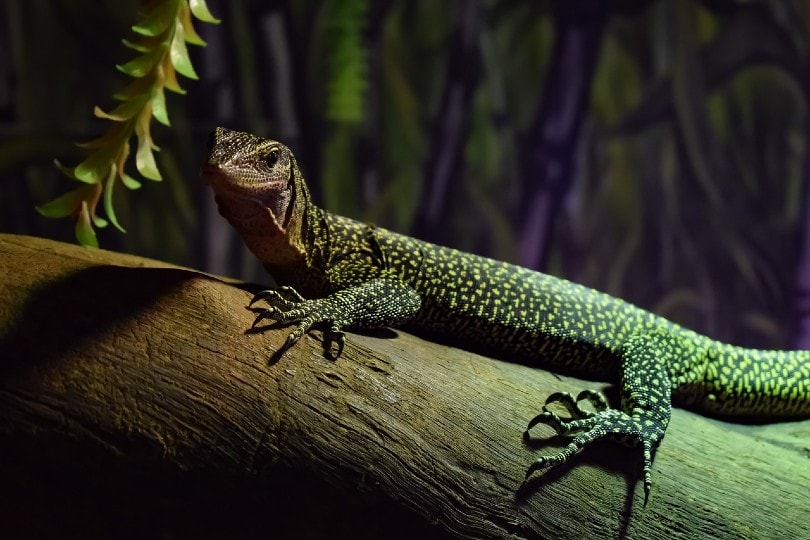

Peach-Throat Monitor Lizards are native to the rainforests of New Guinea. With a stunning appearance and large size, these lizards are a favorite among many experienced reptile owners.
These lizards are mainly only owned by experienced reptile owners because they can be a bit tricky to care for. Even when owned by experienced reptile owners, Peach-Throat Monitor Lizards can be tricky to care for.
With the right care and experience, Peach-Throat Monitor Lizards can be a great addition to your home. They are stunning, docile, and large, making them a joy to look at, though they don’t like being held. If you want to know more about the Peach-Throat Monitor Lizard or think you may have what it takes to own one, read on.

Quick Facts About Peach-Throat Monitor Lizards
| Species Name: | Varanus jobiensis |
| Family: | Monitor lizards |
| Care Level: | Intermediate to experienced |
| Temperature: | 85 – 90 degrees Fahrenheit; 70% – 90% humidity |
| Temperament: | Docile but nervous |
| Color Form: | Various, peach throat |
| Lifespan: | 10 – 15 years |
| Size: | 3 – 4 feet |
| Diet: | Insects, pre-killed rodents, fresh shrimp |
| Minimum Tank Size: | 10 x 6.5 x 6.5 feet |
| Tank Set-Up: | Tank with basking area, cool area, shade, and items to clime on |
| Compatibility: | Only suitable for experienced exotic reptile owners |
Peach-Throat Monitor Lizard Overview
Peach-Throat Monitor Lizards are an incredibly attractive, large, and finicky breed of lizards. They are known and named after their distinctive peach or salmon colored throat, though the coloration fades as the lizard ages.
The Peach-Throat Monitor Lizard is native to New Guinea. There, it lives in tropical environments, which are hot and humid. These lizards need specific temperature and humidity requirements within their enclosures as a result.
Even though this lizard is highly attractive, it is not suitable for most people to own. The lizard is incredibly large, and it has finicky tank requirements. Not to mention, the lizard and its work tank are really costly to get.
This does not even factor in how large these lizards are. Peach-Throat Monitor Lizards are not your average salamander or everyday lizard. They are very large and require a whole lot of space. If you do not have space in your home, this is not the lizard for you.
On the other hand, Peach-Throat Monitor Lizards tend to be very docile and nervous, even if you have the skills, means, and space to care for them. They do not like being handled and are best on their own. If they feel trapped, they may fight back, though this is unlikely.
All around, Peach-Throat Monitor Lizards are really attractive and unique, but they do not make the best pets because of how difficult they are to take care of. We only recommend this pet if you are an experienced lizard owner.
How Much Do Peach-Throat Monitor Lizards Cost?
Peach-Throat Monitor Lizards are not common pets. They must be found by reputable breeders at special exotic pet stores. Because these pets are not very common, you can expect to pay between $300 and $500 for the lizard.
That price does not even consider the cost of the tank or food. Because Peach-Throat Monitor Lizards require such big enclosures, their habitats are quite a hefty bill in and of themselves. These price considerations mean that you must have an ample amount of money to support this lizard.
Typical Behavior & Temperament
Peach-Throat Monitor Lizards are known for being docile by nature. They are generally peaceful and not prone to aggression, but they do have sharp teeth and a strong tail they will use if they feel forced to. This breed also defecates on items they perceive as a threat.
In most cases, the Peach-Throat Monitor Lizard will not act in this way, but it is an extremely nervous breed. Especially when the lizard is not yet used to you, it is known to run around frantically whenever it becomes stressed.
Because these lizards are so nervous, they are best to be left alone. We don’t recommend handling Peach-Throat Monitor Lizards. Even when it comes to cleaning their cage, we recommend checking their mood beforehand so that you don’t make an already nervous lizard more nervous.
Appearance & Varieties
Peach-Throat Monitor Lizards are a stunning breed. They look very similar to mangrove monitors, but they have some different appearances. For example, their head is dark and pattern-less, while their eyes are round, and tongue is pink and pronounced. Notably, their eye has a dark stripe that runs longitudinally through it.
Peach-Throat Monitor Lizards are most recognizable by their throat and temporal regions. As their name suggests, this region is peach or salmon-colored. Young lizards have much brighter colorings than older ones.
These lizards can have many color and pattern variations. For example, some are covered in small yellow spots, whereas others have a dark brown or olive coloring.

How to Take Care of Peach-Throat Monitor Lizards
Peach-Throat Monitor Lizards can be difficult to take care of. Even experienced reptile owners find these lizards to be a challenge. They need a lot of space and specific needs for their enclosure.
Habitat, Tank Conditions & Setup
Your goal should be to make the tank as close to their native environment as possible. First of all, you want to make sure that the habitat and tank is big enough for this large lizard. Adult monitor lizards can grow to be 4 feet long. The tank needs to be big enough so that it can handle this breed moving around.
The tank size should be at least 10 x 6.5 x 6.5 feet. However, we recommend trying to create as big of a space as possible. Your lizard will be really appreciative of the extra space provided.
No matter the size of the tank, make sure it is made from durable materials. Like many other lizards, Peach-Throat Monitors rub against the enclosure and are rough on it. Opt for sturdy materials that are non-splintering. It’s also a good idea to add a separation in front of the screen so that your lizard doesn’t injure itself.
Bedding
In addition to having a large tank, you have to fill that tank up with items that replicate the Peach-Throat Monitor Lizard’s natural home. Bedding is one of the most important factors to consider because it helps to retain moisture.
We recommend using a mixture of cypress mulch, coconut bark, and soil. Make sure that you layer the substrate into the tank at least 5 inches thick. These lizards like to burrow. So, they need enough substrate that they can burrow into.
Temperature, Lighting & Humidity
Peach-Throat Monitor Lizards are difficult to take care of because they have very specific temperature, lighting, and humidity needs. The enclosure needs to have a temperature gradient so that the lizard’s internal temperature is regulated.
For starters, the tank needs a basking area and a cool down area. The gradient should be between 85 degrees Fahrenheit and 90 degrees Fahrenheit. The basking area should be 95 degrees Fahrenheit.
Just like any other lizard, the Peach-Throat Monitor Lizard needs additional lights. We recommend a 12-hour on and 12-hour off schedule. It is also a great idea to add UVB lighting to ensure your lizard gets all the nutrients it needs. Only put the UVB light on for about 30 minutes a day.
As for humidity, Peach-Throat Monitor Lizards need their enclosure to be between 70% and 90% humidity at all times. You can help maintain high humidity by selecting a good substrate and misting the tank. To ensure that the tank is the right humidity, invest in a good hygrometer. Cheap options often give false readings.
Finally, you need to add additional items to the Peach-Throat Monitor Lizard’s home. These lizards love climbing on things and exploring. Place a tree trunk within the enclosure and other items for them to climb on. Artificial plants with huge leaves are a great choice because they provide both shading and hiding locations.
You may even want to add a pool of water so that the reptiles can fully immerse themselves. Even though the lizards won’t swim, they will like sitting in the water. Plus, this body of water will add humidity to the enclosure.

Do Peach-Throat Monitor Lizards Get Along with Other Pets?
It is best to keep a Peach-Throat Monitor Lizard alone in its enclosure. Do not bring other animals or creatures into the tank unless it is the lizard’s food. Other animals can harm or scare the Peach-Throat Monitor Lizard.
What to Feed Your Peach-Throat Monitor Lizard
Even though Peach-Throat Monitor Lizards are difficult to take care of in terms of their habitat, they aren’t too picky about their meals, thank goodness. Most Peach-Throat Monitor Lizards will eat just about anything, including mealworms, crickets, rodents, and even canned dog food.
For baby Peach-Throat Monitor Lizards, stick to live insects like crickets or mealworms. Juvenile and adult lizards can have pre-killed rodents, fresh shrimp, and live insects. Before placing food in the lizard’s enclosure, we recommend adding a calcium dusting to ensure the lizard gets all the nutrients it needs.
We do not recommend catching your own grasshoppers or crickets to feed to your lizard. Although the lizard will likely eat these insects, you never know when wild-caught insects are exposed to pesticides and other harmful items that can harm your lizard.
Keeping Your Peach-Throat Monitor Lizard Healthy
Peach-Throat Monitor Lizards do not have the best living rates in captivity because they require such specific tank enclosures. Ensuring that your Peach-Throat Monitor Lizard’s home meets all the stipulations we mentioned above is the top way to keep it healthy and safe.
Additionally, Peach-Throat Monitor Lizards can get respiratory infections, skin infections, vitamin deficiencies, and other issues. One of the downsides of Peach-Throat Monitor Lizards is that their illnesses can take them out really quickly before you even have a chance to realize there is an issue.
Pay close attention to your lizard’s breathing, activity levels, eating habits, and mucus. If you notice a change in any of these parts of your lizard’s life, take it to see an exotic veterinarian with experience with exotic reptiles.
Breeding
Most Peach-Throat Monitor Lizards are gathered from the wild. There are very few reports of successful breeding within captivity. Even among experienced lizard breeders, breeding Peach-Throat Monitor Lizards is incredibly difficult.
Although it is possible to breed Peach-Throat Monitor Lizards in captivity, it is incredibly difficult, very financially and time draining, and often leads to poor results. We do not recommend breeding this lizard at home.
In the wild, mating occurs right after the rainy season. Around 40 to 55 days after, eggs may be laid.

Are Peach-Throat Monitor Lizards Suitable for You?
Peach-Throat Monitor Lizards are highly attractive and unique, but they are difficult to take care of. For most lizard lovers, we would not recommend this breed simply because of how large, taxing, and difficult they are to take care of.
If you have the skills and means to take care of this lizard, they are docile and attractive, meaning you will have a lot of fun watching them, but you should not try to touch them unless they get accustomed to you. Other than that, we would recommend selecting another breed that is more reliable and easier to care for in captivity.
Featured Image Credit: Dimitris Vetsikas, Pixabay
Nicole is the proud mom of Baby, a Burmese cat and Rosa, a New Zealand Huntaway. A Canadian expat, Nicole now lives on a lush forest property with her Kiwi husband in New Zealand. She has a strong love for all animals of all shapes and sizes (and particularly loves a good interspecies friendship) and wants to share her animal knowledge and other experts’ knowledge with pet lovers across the globe.





